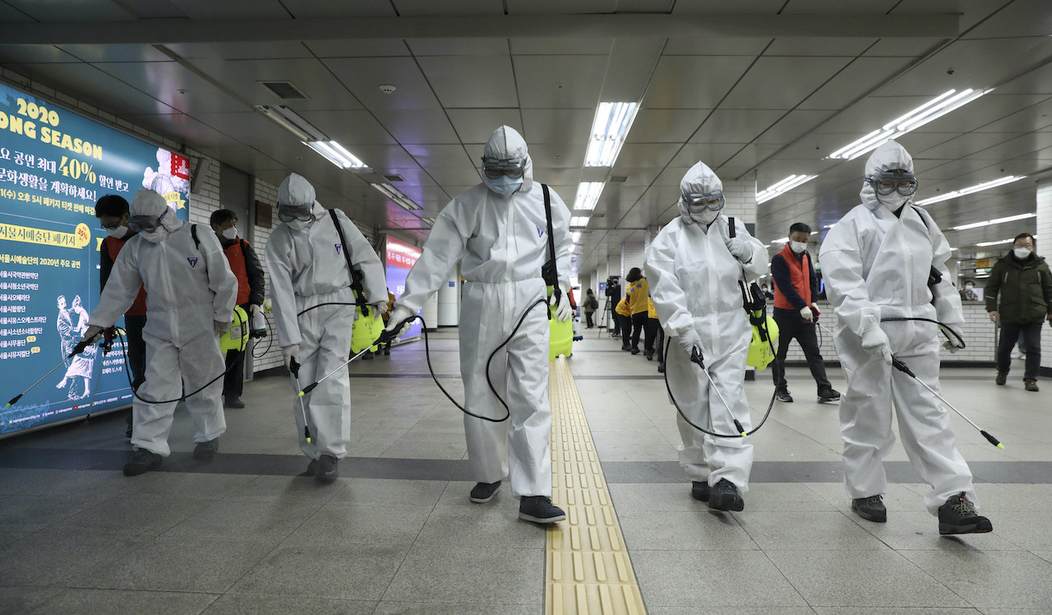A lesson from the Far East that even the most well-laid plans to contain the virus will eventually go awry, especially when there’s a hyper-hypercontagious new subvariant circulating.
COVID is inevitable, it seems. Although, as we’ll see, mass death from COVID is not.
Over the past two years we’ve all gotten to know what a typical epidemiological curve looks like. It’s a roller coaster, with steep peaks in infections forming over two or three months followed by similarly steep plunges before the next peak begins to build.
But that’s not every country’s experience. Imagine a curve that looks like a car chugging along on flat terrain for mile after mile — only to suddenly be tractor-beamed into outer space. That’s the South Korean experience. Uh-may-zing:

From February 2020 all the way to January 2022 without a blip. South Korea was the proof that mass contagion by the coronavirus wasn’t inevitable, that it could be controlled by a population that took precautions diligently and by a government that was serious about using technology to facilitate contact tracing. The Koreans had beaten COVID.
Then Omicron and its more infectious subvariant, BA.2, showed up. Look again at the Y-axis in the graph above and gape at the number of cases South Korea is suddenly recording. A country of 52 million people is averaging 400,000 per day lately, tantamount to around 2.5 million per day in the U.S. when adjusted for population. The peak of the actual U.S. Omicron wave this winter was an average of 800,000 per day. They’re doing three times as many cases per capita as we did at our peak.
Even if we want to attribute some of that disparity to South Korea testing more comprehensively than the U.S., which is a safe bet, that’s a staggering number of cases. Check this out:
2) Omicron is NOT mild. It’s highly contagious and vaccine evasive. You see that when it enters a country where almost no one has had COVID before.
You can see how it dwarfs the peak in cases that occurred in the US. A peak we considered so high and undwarfable. pic.twitter.com/rM31djP800
— Vincent Rajkumar (@VincentRK) March 13, 2022
Here’s how quickly the Koreans have managed to close the gap on Americans in total cumulative cases per capita in just two months:
In 2020 and 2021, South Korea was a global COVID success story.
In January 2022, the US had 13x more cases per capita.
Today, the US has just 1.3x more cases per capita.
Korea’s success, *by this one metric*, has updated negatively by an order of magnitude. pic.twitter.com/i7YxkPTWTC
— Derek Thompson (@DKThomp) March 21, 2022
I wonder how many countries on Earth have had a period of mass infection since the start of the pandemic like the one Korea’s going through now. Maybe India during its horrendous Delta wave last spring?
You can’t stop the ‘rona. You can’t even hope to contain it. That’s the lesson of South Korea’s outbreak.
But you can hope to delay a mass outbreak until most of your population has been vaccinated, cutting the eventual death toll dramatically. Deaths are up lately in South Korea, but compare this Y-axis to the one in the graph above:

At around 300 deaths per day, they’re experiencing the equivalent of 1800-1900 deaths in the U.S. — a heavy toll, for sure, but nothing Americans aren’t used to by now. In fact, the U.S. has seen peaks in deaths considerably higher than that. Last month we averaged 2,700 per day during the worst of the Omicron wave. A year earlier, during the winter wave of 2021, we topped 3,300 average deaths at one point. How did South Korea avoid that? How are they experiencing a surge in cases unlike any the U.S. has ever seen without a similarly outsized surge of deaths?
It’s easy to guess:

They couldn’t contain the virus forever. But they contained it long enough to give most of their population a chance to get vaxxed, which meant far less severe illness and death once the mega-wave finally crashed down. Derek Thompson flags this comparison of deaths per capita:

Australia is another country in the Far East that took maximum precautions until mass vaccination was feasible. They finally opened back up once a certain percentage of the population was vaccinated. And they’ve also reaped the benefit in the form of fewer deaths lately:

During its peak last month, Australia — a country of 25 million — averaged 87 deaths a day. Per capita, that would be 1,200 or so deaths in the U.S. That’s about the same number of daily deaths America is averaging *right now,* weeks after cases here began to drop precipitously.
Despite the mind-boggling case counts, South Korea is so confident that it won’t experience an India-style disaster of mass death from its wave that it just relaxed certain restrictions in the middle of its wave. Some scientists are mortified, noting that hospitals there are already strained, but the government doesn’t want to burden businesses any more than is absolutely necessary.
By the way, to see what happens when a country with little natural immunity from COVID experiences a sudden wave but doesn’t have a large percentage of its population vaccinated, scroll through the data for Hong Kong. Less than 30 percent of Hong Kongers are boosted, with a particularly ominous shortfall in vaccinations among the very old. Result: Hong Kong is currently seeing around the same number of deaths per day as South Korea … despite having only one-seventh the population.







Join the conversation as a VIP Member